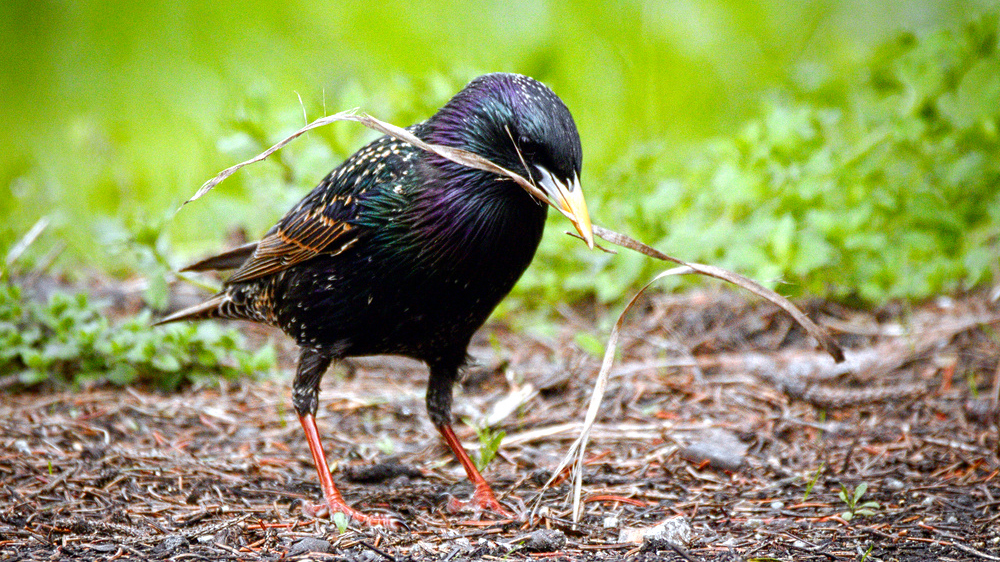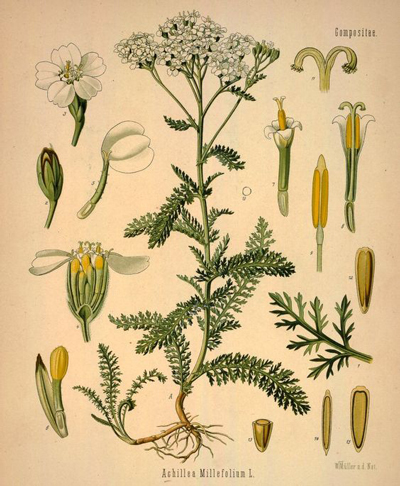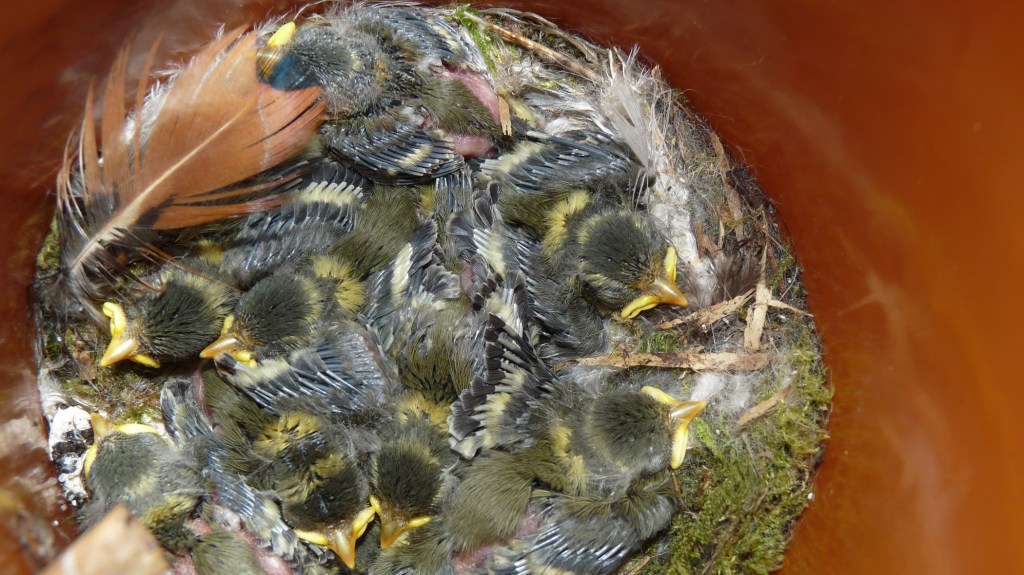“Not all pharmacists are human.” So begins a 1993 review article on the use of medicinal plants by animals. Reading on, we learn that pharmacists can be chimpanzees, Kodiak bears, starlings and grackles. As we learn more about how animals use plants to prevent and treat ailments, this list has only continued to grow. It now even includes caterpillars.
Self medication defined: When a substance is deliberately sought out that prevents or cures a condition and its use results in increased survival and reproduction.
For example, if you get an infection, you take antibiotics that cure the infection which might otherwise kill you.
A non-human example concerns starlings. These birds deliberately choose specific plants (that they find with their sense of smell) to include in their nests. The aromatic compounds emitted by these plants boost immune systems of chicks and reduce their bacterial loads.
Yarrow (Achillea millefolium) is one of the plants used by starlings, along with goutweed (Aegopodium podagaria), hogweed (Heracleum sphondylium), elder (Sambucus niger), cow parsley (Anthriscus sylvestris) and white willow (Salix alba).

A subsequent experiment added yarrow to the nests of tree swallows, which don’t normally use medicinal plants. The result: the abundance of blood-sucking fleas was reduced in nests containing the plant.
Corsican blue tits also add plant material to their nests. They use lavender (Lavandula stoechas), mint (Mentha suaveolens) and an aster (Helichrysum italicum).
These birds add fresh plant fragments throughout the nesting period. When researchers experimentally removed these aromatic plants from their nests, the birds quickly replaced them.

For good reason it seems – chicks in nests with aromatic herbs had higher body and feather growth rates. The herbs also reduce the amount of and diversity of bacteria living on chicks.
Eagles and wood storks choose nesting material from trees and shrubs containing insect-repellent resins. Bonelli’s eagles preferentially use pine boughs for nest construction. Nests with a greater pine composition have lower parasite levels and fledge more young eagles.
House finches in Mexico City have made a recent innovation, achieving better living through chemistry. They have begun using cigarette butts as nesting material. Research demonstrated that cigarette butts reduce the parasites in nests.
The twist is that, as we’ve learned ourselves, synthetic chemicals can have unintended consequences. In the case of house finches, chicks from nests full of cigarette butts have increased chromosomal abnormalities.
Remarkably, every single plant mentioned above has a long history of medicinal uses by humans.

Although there has been relatively little research on medicinal properties of plants like yarrow, their use by people extends deep into our history and prehistory. We have a detailed written record of the use of medicinal plants on Sumerian tablets 5,000 years ago. And 60,000 years ago, Neanderthals were using yarrow and chamomile. It may well be that some of our herbal remedies still in use today could date very far back, even before the human species evolved.
How does the use of medicinal plants emerge in species from songbirds to great apes? Were Neanderthals wearing lab coats doing controlled trials? What about starlings?
In some of the literature there is a notion that self medication, particularly in primates, is the result of observation, learning and conscious decision-making that is then passed on by example. A chimpanzee might learn by association that chewing the bitter pith of the Vernonia plant helps cure an intestinal parasite. It then continues to use the behavior when appropriate and others around it follow the example. This can’t be the whole story though, and it doesn’t do much to explain how a simpler creature would know when and how to self-medicate.
Imagine your own use of herbal remedies. The effects are subtle, societal skepticism can be high, and the placebo effect is strong. How on earth could you learn what plant remedy works and for what ailment if you were just randomly sampling stuff?

Even today, in the absence of controlled medical research on most medicinal plants, much of their use depends on tradition, intuition and belief.
There’s no doubt that many of these plants and the compounds they contain have medicinal value. But where does this ancient wisdom come from that could inform everything from a caterpillar to a chimpanzee to self-medicate?
The answer is natural selection. Without the need for the scientific method, without even the need for awareness and insight, natural selection has an uncanny way of revealing the behaviors that work and those that don’t.
For example, a few trendsetting starlings begin using aromatic plants in nests and subsequently have greater reproductive success. Over time, the tendency to use medicinal plants gradually becomes coded into the gene pool.

This is not to say that learning and communication don’t play a role in spreading the behavior in more social and cognitively advanced animals like chimpanzees.
For humans, given that we’ve been using plants like yarrow for tens of thousands of years, perhaps we too began using some medicinal plants not through learning or trial and error but through natural selection.
We of course have more ways than one to gain insight. There is at least one documented example of a human learning of a medicinal remedy from an animal. In the early 20th century a Tanzanian medicine man noticed that a pet porcupine with dysentery was eating the root of a plant that people regarded as poisonous. He began treating people with the root with great success and and its use as a remedy for dysentery became widespread.
This example suggests that great discoveries are possible by continuing to study the use of medicinal plants by animals. While the European plants used by starlings and blue tits are well known to us, there may be a much greater amount of undiscovered medicinal compounds being used by animals of all sorts around the world. And some of these could be beneficial to humans. It is clear that we have only just begun documenting the phenomenon.




Mr Smith.
This is a great article, but please, PLEASE list your resources at the end, as many of your hyperlinks are broken and give no indication of how I might be able to find those sources otherwise.
Thank you.
What brought me to your blog was, I was looking for information on birds eating or using mint leaves.
I am just a backyard bird enthusiast, and enjoy watching the habits of birds.
I noticed yesterday that both the starlings and the crows, have been tweeting off leaves from a mint plant, and even just rustling their heads in the plant.
The starlings even took a few leaves and brought them to the water dish as well, which I found very interesting.
Thank you for this blog, I hope to read more information on herbals and how birds use them.
My grandmother and my mother believed in herbal solutions for many common allergies and abdominal disorders like we use Munaqqa (the dried form of Grapes with seeds) to get rid of the congestion in the winters.
We use to boil ginger and clove combined with green Tea and take to soothe throat infections
we use lemon in all green tea after dinner regularly as it helps digestion especially after having bar-b-Que
We use Ispaghol Husk to cure abdominal disorders, if there is constipation we take one teaspoonful with warm water and take the same quantity in cold water to cure loose motions.
To add to comment please: This morning there were no dead pigeons, and non sick, either!
Good day!
During the past few weeks we have had many of the pigeons that live around our building just die, and I did inspection daily to not the dead. Two days ago I found an ailing pigeon sitting listlessly under a plant and walked right up to it and spoke to it. no, it did not reply, but did not even look at me. About an hour later, it just staggered away from its position. A few hours later I found this bird to have wandered about 10m from the original spot, and had been joined by an equally sick looking pigeon.
About an hour later some body fed the birds and sick no.1 started feeding, to my surprise, while sick no.2 had taken its place under the same plant that no.1 had been sitting under. That is why I found this article. I will keep looking!
for a better life , we need to better define and understand nature.
thank you for this beautiful and enlightening information.
Noticed House Sparrows collecting Yarrow in my garden and taking it into there nests this is the first time I have seen this behaviour . Very interesting and thought provoking article
If a bird finds utility in using a particular plant, how does this BEHAVIOR get coded into the DNA which is the only mechanism — other than mimicry (or ‘teaching’) — for passing information to the next generation? Are you suggesting that behavioral details which are successful and promote survival – so that the adult animals / birds reproduce preferentially – can be transferred to offspring to modified DNA? If yes, this is a radical departure from traditional Darwinian evolution. (P.S. I omitted “direct communication”, which is mentioned by many other Commenters. It should be another mechanism. Is it more or less likely than modifications by behavior on DNA?)
Very interesting article Joe.